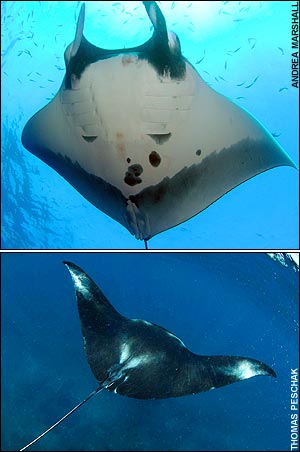New Manta Ray Discovered
Posted by: Loren Coleman on July 24th, 2008

The newly-discovered larger, migratory manta ray (top) and the common, resident species (below)
A new species of manta ray has been identified for the first time.
After five years of study a marine biologist has confirmed that a larger and more elusive manta is in fact a distinct species. Until now it was thought that there was only one manta ray species.
The newly-discovered species leads a different lifestyle to its smaller cousin and is migratory rather than residential.
Andrea Marshall is a PhD marine biologist sponsored by the Save Our Seas Foundation (SOSF) to advance scientific knowledge of the ray whose large triangular pectoral fins can span almost 8m in width and can weigh more than 2,000 kg.
She suspected the existence of a separate species and was able to confirm her theory through genetic and morphological analysis. There may even be a third manta species that exists across temperate, tropical and subtropical waters worldwide.
Marshall revealed her findings at the American Elasmobranch Symposium in Canada.
In 2003 she moved to a small coastal village in southern Mozambique, to become the first marine biologist to study manta rays off the African coast.
Her observations of the unique spot patterns on the ventral surface of each ray enabled the identification of more than 900 individuals on a single reef, and she believes that southern Mozambique may boast the largest known population of manta rays in the world.
The discovery of a new species is likely to affect conservation ideas and policies about rays.
The two species of manta have overlapping distributions and prior to Marshall’s research they were thought to be one and the same kind.
The manta now confirmed as a distinct species is the larger of the two and shys away from divers rather than seeking interaction.
Little is known about its lifestyle or migration patterns and Marshall has only ever witnessed it arriving at sea-mounts or at particularly productive areas along a coastline to feed on plankton before disappearing back into the deep ocean.
Unlike the more resident species the ray is defenseless and does not possess a sting in its tail.
Other differences between the two species lie in colour, skin texture and reproductive biology. The smaller of the two species is not migratory and is often encountered at coral reefs where they congregate to be cleaned by parasite-eating fish in locations such as Hawaii, the Maldives, Mozambique, Australia, Japan and the Island of Yap.
The more commonly known ray resides in the same areas year round making it particularly susceptible to fishing pressure. If resident rays continue to be fished unsustainably they face localised extinction.
The larger rays, migrants and ocean wanderers which makes conservation management difficult, are fished heavily particularly in southeast Asia, and thousands are killed each year.
Many fall victim to ghost nets and are killed alongside other marine creatures as by-catch. Rays are also threatened by habitat degradation, boat traffic and disturbance by divers.
Marshall has also uncovered some of the reproductive behaviour of these mysterious giants which are the largest of the ocean’s 500 different species of rays and skates. Manta rays are now known to give birth to a single large offspring about 1.4m in size after a year of gestation and, once reaching maturity at about 4m across, typically produce a pup every other year.
They perform elaborate and sophisticated courtship displays, are highly social and inquisitive, and may communicate with one another using specific body posturing and possibly sound.
SOSF aims to learn more about the role of marine species, particularly sharks and rays, and through this knowledge it hopes to raise awareness and conserve the marine realm.
Source: “New manta ray species discovered,” by Cheryl-Samantha Owen, Telegraph, July 24, 2008.
About Loren Coleman
Loren Coleman is one of the world’s leading cryptozoologists, some say “the” leading living cryptozoologist. Certainly, he is acknowledged as the current living American researcher and writer who has most popularized cryptozoology in the late 20th and early 21st centuries.
Starting his fieldwork and investigations in 1960, after traveling and trekking extensively in pursuit of cryptozoological mysteries, Coleman began writing to share his experiences in 1969. An honorary member of Ivan T. Sanderson’s Society for the Investigation of the Unexplained in the 1970s, Coleman has been bestowed with similar honorary memberships of the North Idaho College Cryptozoology Club in 1983, and in subsequent years, that of the British Columbia Scientific Cryptozoology Club, CryptoSafari International, and other international organizations. He was also a Life Member and Benefactor of the International Society of Cryptozoology (now-defunct).
Loren Coleman’s daily blog, as a member of the Cryptomundo Team, served as an ongoing avenue of communication for the ever-growing body of cryptozoo news from 2005 through 2013. He returned as an infrequent contributor beginning Halloween week of 2015.
Coleman is the founder in 2003, and current director of the International Cryptozoology Museum in Portland, Maine.










Great story, Loren!!!
Enjoyed reading about the new manta discovery. Beautiful photos too!
Great story. I like the way the new manta bodies weren’t kept in a freezer for awhile while T-shirts were sold and manta finding expeditions for the public were mounted. 🙂
I’ve always thought that mantas were gorgeous creatures–thanks for the article!
That’s cool. Funny, just the other day I read an article in the news about some guy searching for legendary rays of monstrous proportions. Coincidence?